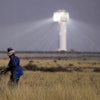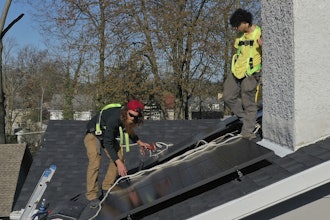NEW ORLEANS (AP) -- Undersea robots maneuvered a mile beneath the Gulf on Monday to delicately lower a new, tighter-fitting cap over BP's broken well, a fix the oil giant hopes can finally stop the leak after nearly three months.
The new cap, a 150,000-pound (68,000-kilogram) metal stack, was about 300 feet (90 meters) from where it's supposed to be installed on top of the leaking well, BP Chief Operating Officer Doug Suttles said in a Monday morning news briefing.
A swarm of remote-controlled robots moved around heavy equipment near the seafloor on live video provided online by BP PLC. It was not clear how close the cap was to the well, but Suttles said the operation was complex and could take longer than they expect.
Oil could still be seen flowing freely from the top of the well where the cap will be attached.
The BP executive was careful to keep expectations grounded, stressing that once the cap is in place, it will take days to know whether it can withstand the pressure of the erupting oil and feed it through pipes to surface ships. The cap and vessels together make up BP's plan to stop oil from spewing into the Gulf for the first time since April 20.
"Until we have the cap on, securely fitted in place, and know it's operating per the design, we have to recognize this is a complex operation," Suttles said.
It is the nation's worst offshore oil spill. The well has spewed between 89.3 million (340 million liter) and 176.4 million gallons (670 million liters) of oil into the Gulf of Mexico, according to federal estimates. The Exxon Valdez spilled about 11 million gallons (42 million liters).
Gulf residents were wary after weeks of failed efforts to stop the spill and downcast about the damage already done to the biologically rich Gulf and the coast's two leading industries, fishing and tourism.
BP has tried and failed to counter the gusher with a giant concrete box over the well, mud and shredded rubber pumped into it and a pipe to siphon the crude.
First lady Michelle Obama was expected in Panama City, Florida, on Monday to meet with local community leaders and tourism officials. The Panhandle city recently opened a new international airport to draw additional tourists to the area but the oil spill has kept many away -- even though pollution on local beaches has been minor so far.
BP's new cap is designed to snap into place atop the well, held by a connecting piece that was installed overnight on top of the well pipe, said Eric Smith, associate director of the Tulane Energy Institute.
Once the cap is firmly in place, the company will begin "shutting in" the well by closing perforated pipe at the top. The company will be looking to see if the pressure rises inside the cap. If it does, that means there are no other leaks, and the cap is stopping oil from leaking into the Gulf.
But lower pressure readings may indicate leaking elsewhere in the well. In that case, Suttles said, the company will work to collect the leak with surface vessels and by dropping yet another cap on top of the stack.
The testing should last about 48 hours, Suttles said.
Even if the tests show the cap is successfully holding in the oil, it will not be the final fix for the blown well. That will have to wait until one of two relief wells reaches the leaking well from underground and can inject heavy drilling mud and cement to form a permanent plug.
BP expects one relief well will do the job, but it's drilling a second as a backup. Officials have offered varying estimates for when that work will be done, but mid-August is the most common timeframe.
Work on the new cap has been moving briskly, with the old, leaky cap coming off the well on Saturday. One snag in the operation has been a delay in the startup of a vessel called the Helix Producer, which is supposed to connect to the well by a link below the cap, ultimately collecting roughly 1 million gallons (3.8 million liters) of oil a day.
The ship was supposed to begin collection Sunday, but two minor technical glitches prevented that, Suttles said. He expects the ship to begin Monday, reaching full capacity within two days or so.
Weber reported from Houston. Associated Press Writer Mary Foster in Yscloskey, Louisiana, contributed to this story.



















